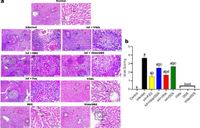A combination of Vildagliptin and Diaminodiphenyl Sulfone shows potential in reducing hepatic fibrosis caused by Schistosoma mansoni infection in mice, according to a recent study from Theodor Bilharz Research Institute.
Schistosomiasis is a neglected tropical disease that affects over 250 million people worldwide, contributing to significant morbidity and mortality. Currently, praziquantel (PZQ) is the primary medication used to treat the infection, but its efficacy is limited, particularly regarding fibrotic liver damage that develops as a result of the disease. Researchers are thus exploring combinations of existing drugs to enhance treatment outcomes.
The study, published on March 24, 2025, evaluated the hepatoprotective effects of Vildagliptin (Vilda), an antidiabetic drug, and Diaminodiphenyl Sulfone (DDS), long known for its anti-inflammatory properties, when administered separately and in combination (Vilda/DDS). Mice infected with Schistosoma mansoni were treated with PZQ for two consecutive days, followed by treatments of Vilda, DDS, or Vilda/DDS for a duration of 14 days. The impact of these treatments was assessed through various parasitological and biochemical methods.
Results demonstrated that treating S. mansoni-infected mice with Vilda, DDS, and Vilda/DDS led to significant reductions in worm counts and egg production, which are critical measures of the infection's severity. The researchers noted, "Vilda/DDS showed antioxidant, anti-inflammatory and antifibrotic activities in comparison to either Vilda or DDS alone against S. mansoni-induced hepatic fibrosis," emphasizing the combination's superior effectiveness.
Moreover, the treatments fostered improvements in the hepatic Nrf2/HO-1 pathway, leading to increased superoxide dismutase (SOD) levels and decreased malondialdehyde (MDA) levels, markers indicative of oxidative stress. This change is crucial as oxidative stress contributes significantly to the tissue damage seen in liver fibrosis. As described by the authors, "The treatments enhanced the hepatic Nrf2/HO-1 pathway with significant increasing SOD and reducing MDA levels," reflecting the potential for these compounds to mitigate oxidative damage.
In parallel to the parasitological improvements, significant downregulation occurred in markers associated with inflammatory responses and fibrosis. The treatments reduced expression levels of pro-inflammatory cytokines such as TNF-α and caspase-1, further supporting their roles in managing the inflammatory responses driven by schistosomiasis. The research found that S. mansoni infection led to the highest levels of collagen deposition in liver tissues, a hallmark of fibrosis. Importantly, infected mice receiving Vilda/DDS showed a 78% reduction in collagen fibers, highlighting the therapeutic potential of this combination in managing liver fibrosis.
The findings suggest the Vilda/DDS combination not only targets the schistosome directly but also addresses the associated liver complications. The combination exhibited a pronounced reduction in hepatic markers for inflammation and fibrosis, confirmed through comprehensive statistical analysis.
The implications of these findings resonate beyond laboratory studies, as researchers aim to repurpose existing drugs to address unmet medical needs in neglected diseases such as schistosomiasis. As stated by the authors, "Vilda/DDS is a promising approach for managing S. mansoni infection, liver fibrosis, and associated disease morbidity." This research opens avenues for more effective management strategies, potentially providing relief to millions affected by schistosomiasis.
In conclusion, the study underscores the efficacy of repurposed drugs like Vildagliptin and DDS, either alone or in combination, in combating both the schistosomiasis infection and its severe repercussions like liver fibrosis. The research contributes critically to the ongoing efforts to find effective treatments for neglected tropical diseases, aiming for an impactful response to health challenges posed by conditions like schistosomiasis.




